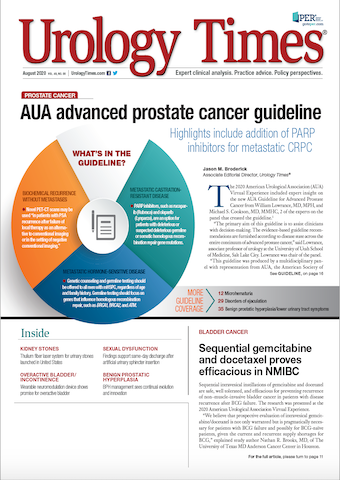Publication
Article
Urology Times Journal
Urology Practice: How do you bill for virtual visits lasting more than 30 minutes?
Author(s):
E/M guidelines direct code selection based on face-to-face time with patient.
Is there is a modifier for telehealth visits when more than 30 minutes are spent with a patient? For instance, what about when time is spent explaining options to a patient with newly diagnosed prostate cancer or when a new patient has complex issues to be discussed?
Jonathan Rubenstein, MD

This is a great question, and for the purposes of this answer, we are assuming that you are describing a virtual visit service provided in the outpatient setting with a patient who is located in their home or at another nonoffice and non-facility/originating site. As of this writing, there are no specific evaluation and management (E/M) codes for those types of telehealth visits, but during this recent public health emergency (PHE) and hopefully afterward, many insurers (including Medicare) are allowing these services to be reported using the typical in-person office and other outpatient site of service E/M codes: 99201-99205 for new patients and 99211-99215 for established patients. Therefore, the same rules for selecting a code will be used for a virtual visit as for an in-person visit.
Mark Painter

If using time for code selection, the current (1997) E/M guidelines direct you to choose a code based upon the time spent face-to-face with the patient, if more than 50% of the time was spent counseling and coordinating care. For example, in the case of a new patient, the code 99205 would be chosen for 60 minutes of face-to-face time, while the established patient code 99215 is for 40 minutes of face-to-face time. This will change slightly with the introduction of the new 2021 E/M guidelines; then, time will be chosen based upon the total time spent on the patient that day, including previsit, visit, and postvisit time. During this PHE, Medicare went ahead and implemented these time guidelines for telehealth visits only.
If the time of visit exceeds the time of the highest level of service (99205 and 99215), prolonged service codes can be used to report these exceptional circumstances. For the first hour, use CPT code 99354 (prolonged evaluation and management or psychotherapy service[s] [beyond the typical service time of the primary procedure] in the office or other outpatient setting requiring direct patient contact beyond the usual service; first hour [List separately in addition to code for office or other outpatient Evaluation and Management or psychotherapy service]). Use 99355 for each additional 30 minutes.
CPT code 99354 can be added on to codes 99205 and 99215 for the first hour of additional time, and it can be used when the time exceeds the maximum time by at least 31 minutes. For example, you can bill CPT codes 99215 and 99354 for a face-to-face time of 71 minutes (40 minutes, plus a minimum of 31 minutes into the first additional hour of 99354). CPT code 99355 can be added on to the first 2 codes for each additional 30 minutes, if you reached 16 minutes past the first additional hour, which, for example, is 136 minutes for 99215 (40 plus 60 plus 16). The exact time in minutes must be documented in the note.
Of course, you will need to report appropriate place-of-service codes and modifiers to indicate that the visit was a telehealth encounter.
When the new E/M guidelines are implemented in January 2021, a prolonged service code for each 15 minutes of work above the maximum time for 99215 and 99205 has been proposed. The details of this code will likely be found in the Proposed and Final Rules for the Medicare Physicians Fee Schedule, which have not yet been released at press time.
Rubenstein is compliance officer and medical director of coding and reimbursement, United Urology Group and Chesapeake Urology, Towson, Maryland. Painter is CEO of PRS Urology SC in Denver, Colorado.
Send coding and reimbursement questions to Rubenstein and Painter c/o Urology Times®, at urology_times@mmhgroup.com.
Questions of general interest will be chosen for publication. The information in this column is designed to be authoritative, and every effort has been made to ensure its accuracy at the time it was written. However, readers are encouraged to check with their individual carrier or private payers for updates and to confirm that this information conforms to their specific rules.
























